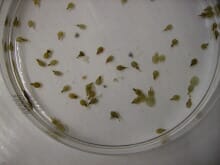Has an accurate picture of lice number and life stages, before and after treatment been gathered? In order for monitoring to be effective, it is crucial that all staff counting lice are trained and that their competence in carrying out lice counting is assessed. Certain lice treatments will only be effective against specific life stages whilst having no effect on others. Therefore the identification of lice life stages combined with the knowledge of lice development times at different temperatures will allow a more accurate assessment of treatment efficacy to be obtained.
In the assessment of treatment efficacy, has the health of the counted lice been considered? Lice counters should be aware of the condition of lice (strength of attachment, area of attachment) the presence of lice parasites such as flukes or epiphytic growths. The latter appear to be good indicators of poor health status of lice and should be noted.
Has the effect of temperature been taken into account? Post-treatment “drop off” of lice can be significantly affected by water temperature.

Has the treatment been applied effectively? Estimating tarpaulin volume in bath treatments is well known as a dark art. The experience of the team putting a tarpaulin around a pen, the effect of tide, wind conditions and sometimes even the age of the tarpaulin (older tarpaulins can stretch), can all contribute to varying volumes of water enclosed for dosing.
It is also important to use accurate treatment biomass data and to double-check all dosage calculations, as even a slight error can have significant result on efficacy of either bath or in-feed treatments.
Have manufacturer’s instructions for use been followed, regarding storage, handling and dilution of products, in the case of bath treatments?
Fish health is an important consideration. An in-feed treatment may not be the most effective choice, where fish appetite has been lowered as a result of disease (such as Pancreas Disease) or where there are a significant proportion of non-feeders, such as early maturing fish, within the population.
In the case of an in-feed treatment, is there an accurate estimation of both the biomass to be treated and the appetite of the fish? Feeding rates and the delivery of feed to fish can have a significant bearing on the success of in-feed treatments. Husbandry measures, such as the turning on of cage lights, can also have a significant but short-lived effect on appetite. If nets are heavily fouled, an in-feed treatment might be a more successful, and safer, option than a bath.
Sea lice bioassays are best employed prior to treatment, to judge whether the preferred lice medicine is going to effectively kill the lice but can also prove useful in any investigation, following a suspected treatment failure.
In the case of an in-feed treatment, it is good practice to routinely freeze a sample of medicated feed and take flesh samples post treatment, to assist in investigation of treatment failure, should it arise. Collection of data, such as medicine batch numbers and expiry dates provides useful information for investigation of any suspected treatment failure.
Any suspected treatment failure should be reported to the relevant authority (in the UK, it is the Veterinary Medicines Directorate; VMD) using the appropriate 'Suspected Adverse Reaction' forms.
August 2009


